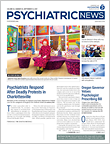In her
president’s column in the July 21 issue of
Psychiatric News, APA President Anita Everett, M.D., called on APA members to join her over the next year in “deep and wide conversations … so that together we can explore the root causes of physician burnout and develop strategies to promote wellness and interventions that can mitigate the effect that they have on physicians not only in psychiatry but across all of medicine.”
We owe Dr. Everett a debt of gratitude for sounding the alarm about a problem that has been mounting in urgency for nearly a decade. Over that period, I have tracked the emergence of physician burnout and believe it is a direct consequence of changes in health care business and delivery models that emphasize productivity to the detriment of the physician-patient relationship and physicians’ well-being.
For me, and for others in medical education who regularly see the toll that stress exacts on our students and trainees, the problem is now acute. I became aware of just how much of an emergency we are facing in the summer of 2014, following a devastating series of events. Just as I began my summer vacation, I received an email from a colleague at the New York University School of Medicine that one of our graduates interning in medicine at Columbia had returned to NYU to jump to his death. A few days later, a medical intern at Cornell also died by suicide. A month after that, I was the only psychiatrist in the room during a meeting of the Board of Directors of the Accreditation Council for Graduate Medical Education (ACGME) when we learned about a fellow in vascular medicine who had taken his life and whose family was committed to helping the ACGME improve the working environment. That trainee’s medical school roommate was also present at the meeting, and the group spent several hours discussing this series of tragedies.
The ACGME Board of Directors, under the leadership of CEO Thomas Nasca, M.D., swiftly acted to galvanize efforts to address physician well-being in the graduate medical education community. These are among the initiatives that are planned or under development:
•
Launching an annual ACGME symposia series specifically devoted to physician well-being.
•
Collaborating with other medical education organizations, including the Association of American Medical Colleges (AAMC), the American Board of Medical Specialties, and the AMA, among others, to address the epidemic of burnout in the health care work force.
•
Developing an action collaborative led by the AAMC and the National Academy of Medicine, focused on ensuring the well-being of the health care workforce as a critical component of the health and well-being of the American public.
•
Working within the Coalition for Physician Accountability to review existing efforts to improve physician well-being at work and identify opportunities and gaps in both research and initiatives to address the problem.
•
Collaborating with the American Foundation for Suicide Prevention and others to provide resources to institutions to encourage help-seeking behavior and offer guidance on how to respond to suicides among physicians and medical trainees.
Perhaps most importantly, the ACGME has included physician well-being, along with patient safety, as a primary focus of Clinical Learning Environment Review (CLER) institution visits and has revised the Common Program Requirements to include a section on resident and faculty well-being. These requirements, designed to help facilitate an environment where residents and fellows can optimally learn, call on institutions to take these actions:
•
Promote meaning in work with patients.
•
Develop policies and programs that encourage optimal resident and faculty well-being.
•
Educate faculty and residents in all medical disciplines to identify individuals who may be experiencing burnout, depression, and substance abuse.
•
Provide access to confidential, affordable treatment 24/7.
I believe that by empowering our colleagues to advocate for their own mental health and well-being, we will further sensitize physicians of all medical disciplines—not just psychiatrists—to the critical significance of mental health issues in the treatment of their patients. In addition, the new urgency around the issue of burnout is a unique opportunity for us to renew our efforts to reduce stigma attached to seeking help, especially within the medical community.
We must also begin at the beginning, with medical training and its long-hidden risk factors for mental illness and burnout. These include, but are not limited to, loss of autonomy in combination with increased responsibility for people’s lives, challenges to circadian rhythms, feelings of isolation, and relocations that may limit the availability of stable support systems. The literature clearly demonstrates that trainees are at high risk for burnout and depression. We must provide training programs with the tools they need, not only to identify and provide treatment for residents in a systematic way, but to work proactively to improve well-being for both trainees and faculty.
The Board of Trustees Workgroup on Psychiatrist Well-Being and Burnout, initiated by Dr. Everett, is a wonderful opportunity for APA to work synergistically with the graduate medical education community. I am proud to be part of two organizations, APA and ACGME, that are stepping up to this challenge. I encourage you to join us in this effort by contacting members of the work group and offering your expertise to your district branch, academic institution, or state or local medical society. This is a problem that we as psychiatrists can address with expertise, but it belongs to all of medicine. ■


